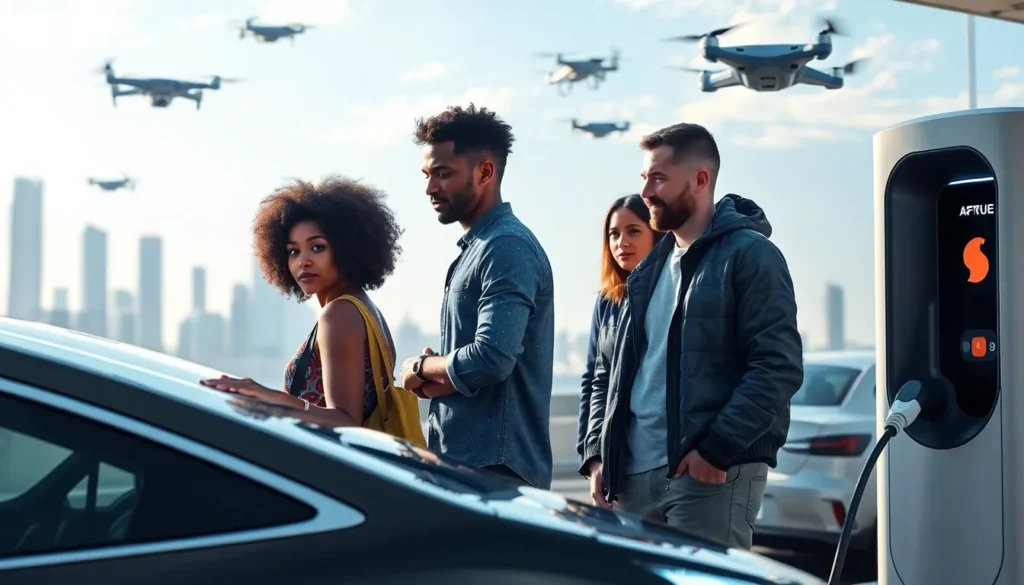Table of Contents
ToggleThe future of transportation is zooming in faster than you can say “flying car.” With emerging technologies reshaping how people and goods move, it’s clear that the days of sitting in traffic might soon be a thing of the past. Imagine gliding through the air in a sleek drone or hopping on a hyperloop that whisks you from city to city in the blink of an eye. Sounds like science fiction? Think again!
As innovations like electric vehicles, autonomous systems, and smart infrastructure take center stage, they’re not just changing the way we travel; they’re redefining the entire experience. Buckle up and get ready to explore the exciting world of transportation technologies that promise to make our commutes more efficient, eco-friendly, and maybe even a little more fun. Who knows? The next big thing might just be around the corner, waiting to revolutionize the roads we travel.
Overview Of Emerging Transportation Technologies
Emerging transportation technologies redefine mobility. Innovations like electric vehicles (EVs) promote sustainability by reducing reliance on fossil fuels. Autonomous vehicles enhance safety, minimizing human errors that often lead to accidents. Drones, utilized for package delivery, shorten transit times and increase efficiency in logistics.
Additionally, smart infrastructure integrates advanced data systems to improve traffic management. Smart traffic signals adapt dynamically to real-time conditions, decreasing congestion and travel times. Hyperloop systems promise ultra-fast travel between cities, revolutionizing long-distance commutes.
Flying cars are no longer science fiction; prototypes exist, and testing continues. These vehicles target urban air mobility, potentially easing ground traffic. Sustainable energy sources, including solar and wind, power many of these technologies, aiming for a greener future.
Furthermore, connected vehicles communicate with each other and infrastructure, enhancing overall safety and efficiency. Real-time data sharing allows vehicles to respond proactively to road conditions, minimizing delays. Collaboration among tech companies, automotive manufacturers, and governments accelerates development and regulation of these technologies.
Investment trends indicate significant growth in transportation innovation. The global EV market alone reached over $400 billion in 2021 and is expected to grow at a compound annual growth rate (CAGR) of 22.6% through 2028. Investment in autonomous vehicles is projected to exceed $60 billion by 2030.
Adoption rates of these technologies depend on consumer acceptance and infrastructure readiness. As cities prepare for integration, the landscape of urban mobility will undergo profound changes. Emerging technologies ensure more efficient, safe, and environmentally friendly transportation options in the near future.
Key Innovations In Transportation

Emerging transportation technologies revolutionize mobility, highlighting the importance of sustainability, efficiency, and safety. Key innovations such as electric vehicles, autonomous vehicles, and hyperloop technology shape the future of commuting.
Electric Vehicles
Electric vehicles (EVs) significantly reduce reliance on fossil fuels, promoting a cleaner environment. The global EV market exceeded $400 billion in 2021 and expects a robust growth rate of 22.6% through 2028. Manufacturers focus on expanding EV infrastructure, making charging stations more accessible. Consumers embrace EVs due to lower operating costs and advancements in battery technology. Enhanced range and performance make these vehicles viable for various lifestyles.
Autonomous Vehicles
Autonomous vehicles prioritize safety by minimizing human errors responsible for many accidents. Investment in autonomous technology is projected to surpass $60 billion by 2030. These vehicles utilize advanced sensors and machine learning, enhancing navigation and interaction with surrounding environments. Real-time data sharing capabilities improve road safety and traffic flow. Over time, consumer trust and regulatory frameworks play crucial roles in widespread adoption.
Hyperloop Technology
Hyperloop technology aims to revolutionize long-distance travel with speeds potentially exceeding 700 miles per hour. This innovative system utilizes low-pressure tubes to transport passenger pods, significantly reducing transit times between cities. Prototypes demonstrate the feasibility of this concept, enticing investments from multiple entities. Furthermore, hyperloop systems capitalize on renewable energy sources, aligning with the global shift toward sustainability. Ongoing research and development pave the way for its future integration into existing transportation networks.
Impact On Urban Mobility
Emerging transportation technologies significantly influence urban mobility dynamics, presenting innovative solutions for contemporary challenges. Cities increasingly adapt to these advancements, enhancing the overall travel experience for residents.
Improved Traffic Management
Dynamic traffic signals respond to real-time conditions, optimizing traffic flow. Data-driven systems analyze patterns, reducing congestion by adjusting signal timings according to actual traffic volumes. Connected vehicles also contribute significantly by sharing information that helps in anticipating bottlenecks. Enhanced collaboration among vehicles, infrastructure, and traffic management systems paves the way for more effective urban transit. Predictive analytics will become crucial for planning and maintaining traffic efficiency.
Sustainable Transportation Solutions
Electric vehicles promote reduced emissions, contributing to cleaner air in urban areas. The EV market’s growth, expected to surpass $800 billion by 2028, highlights a shift towards greener alternatives. Battery technology advancements enable longer ranges, alleviating range anxiety for drivers. Public transportation innovations, such as electric buses, also support sustainability goals by minimizing fossil fuel reliance. Drones and other emerging technologies further promote sustainable urban logistics, streamlining goods delivery while decreasing the carbon footprint.
Challenges And Considerations
Emerging transportation technologies face several challenges that must be addressed for successful implementation.
Infrastructure Requirements
Significant investment in infrastructure is essential to support new transportation technologies. Electric vehicles necessitate widespread charging stations to meet consumer demand. Traditional roads must accommodate autonomous vehicles by incorporating advanced sensor systems. Smart infrastructure thrives on reliable data networks that facilitate real-time traffic management. Without robust integration of old and new systems, operational efficiency diminishes. Cities must also consider urban planning strategies to optimize flow and reduce congestion. As transportation models evolve, readiness for substantial infrastructure upgrades becomes imperative.
Regulatory Hurdles
Complex regulatory frameworks impact the adoption of emerging transportation technologies. Various stakeholders, including governments and agencies, must collaborate to establish clear guidelines. Autonomous vehicles require comprehensive safety standards to gain public trust. Electric vehicle mandates could encourage faster market penetration but face pushback from traditional automotive sectors. Additionally, regulatory bodies must address environmental concerns related to new technologies. Compliance with safety and data privacy regulations is crucial for consumer acceptance. Navigating these hurdles demands strategic policy formulation that balances innovation and public safety.
Future Trends In Transportation
Innovative electric vehicles (EVs) continue to dominate the future of transportation. The global market surpassed $400 billion in 2021, with projections indicating a compound annual growth rate (CAGR) of 22.6% through 2028. Factors like improved battery technology and accessible charging infrastructure contribute to this growth. Performance and lower operating costs drive consumer adoption, projecting an $800 billion market by 2028.
Next, attention turns to autonomous vehicles. These technologies minimize human error, enhancing safety on the roads. Over $60 billion in investment is expected by 2030, leveraging advanced sensors and machine learning. Consumer trust hinges on evolving regulatory frameworks, which will be essential for widespread use.
Hyperloop technology signifies a major leap for long-distance travel. It promises speeds that could exceed 700 miles per hour, utilizing low-pressure tube systems. With prototypes underway, investments align with sustainability goals through renewable energy use.
Smart infrastructure has emerged as a critical component in modern transit planning. Data-driven systems manage traffic by dynamically adjusting signal timings based on real-time conditions. Connected vehicles heighten safety and efficiency by sharing data seamlessly. Enhanced coordination among vehicles, infrastructure, and traffic management systems fosters effective urban transport.
Despite these innovations, challenges persist in adapting infrastructure. Significant investment is vital for developing widespread EV charging stations and advanced sensor systems for autonomous vehicles. Collaboration among stakeholders is crucial for navigating complex regulatory environments. Cities face demands for infrastructure upgrades and strategic policy formulation to ensure a balance between innovation and public safety.
Investment trends reveal transformative shifts in urban mobility. Emerging technologies promise safer, more efficient, and environmentally friendly transportation solutions. Adoption of electric buses and drones stands to improve air quality and reduce carbon footprints in urban environments.
The future of transportation is on the brink of a remarkable transformation. As emerging technologies reshape how people and goods move, the potential for increased efficiency and sustainability is immense. Innovations like electric vehicles and autonomous systems are not just enhancing safety and reducing emissions; they’re paving the way for smarter urban environments.
However, realizing this vision requires strategic investments and collaborative efforts among stakeholders. By addressing infrastructure needs and regulatory challenges, cities can harness these advancements to create a more connected and eco-friendly transportation landscape. The journey toward a smarter mobility future is just beginning, and the possibilities are truly exciting.




